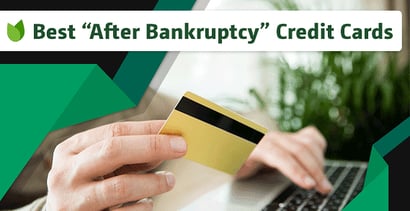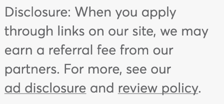

Some of life’s setbacks can be impossible to overcome. Fortunately, bankruptcy is not one of them. In fact, for many people in extreme debt, bankruptcy can actually be the first step to repairing your credit for two important reasons:
- Bankruptcy can reduce or wipe out your debt. Since you now have less (or no) debt, you are in an excellent position to repay the next debt you take on.
- Creditors know you will be willing to pay high interest rates to rebuild credit, and many are happy to offer you their products, which are often the most profitable for the bank.
There are several ways to restore your credit rating after bankruptcy. For example, credit unions offer credit builder loans that can rebuild your credit rating over the course of a year or two. The most feasible method is usually to obtain a credit card, secured or unsecured, and use it responsibly.
After six months or so, you should see your credit score start to improve. Keep reading for a selection of what we believe to be the best post-bankruptcy credit cards available today and learn how to use these cards for a fresh start and a fresh credit score.
Unsecured | Secured | Post-Bankruptcy Advice
Best Unsecured Cards For After a Bankruptcy
An unsecured credit card is one that is not backed by a cash deposit. Even if you are just coming out of bankruptcy, you may be able to procure an unsecured card, but be prepared for a high interest rate, high fees, and a low credit limit. But that’s OK; consider it the price of regaining your credit rating.
We’ve evaluated just about every unsecured credit card geared toward those consumers who need to rebuild their credit ratings, and here are some of the best:
- Up to $1,000 credit limit doubles up to $2,000! (Simply make your first 6 monthly minimum payments on time)
- All credit types welcome to apply!
- Monthly Credit Score – Sign up for electronic statements, and get your Vantage 3.0 Score Credit Score From Experian
- Initial Credit Limit of $300 – $1,000 (subject to available credit)
- Monthly reporting to the three major credit bureaus
- See if you’re Pre-Qualified without impacting your credit score
- Fast and easy application process; results in seconds
- Online account access 24/7
- Checking Account Required
| Application Length | Interest Rate | Reports Monthly | Reputation Score |
|---|---|---|---|
| 9 minutes | 29.99% APR (Variable) | Yes | 8.5/10 |
- Greater access to credit than before - $700 credit limit
- Get a Mastercard accepted online, in store and in app
- Account history is reported to the three major credit bureaus in the U.S.
- $0 liability* for unauthorized use
- Access your account online or from your mobile device 24/7
- *Fraud protection provided by Mastercard Zero Liability Protection. If approved, you'll receive the Mastercard Guide to Benefits that details the complete terms with your card.
| Application Length | Interest Rate | Reports Monthly | Reputation Score |
|---|---|---|---|
| 8 minutes | See terms | Yes | 9.0/10 |
3. Indigo® Mastercard® Credit Card
This offer is currently not available.
| Better Business Bureau | In Business Since | Free Consultation? | Reputation Score |
|---|---|---|---|
| N/A | N/A | N/A | N/A |
Your strategy should be to pay off your balance each month to avoid interest charges. Avoid tapping more than 30% of your available credit limit to maintain a healthy credit utilization, and never miss a payment due date.
Best Secured Cards For After a Bankruptcy
A secured credit card requires you to deposit funds in an account that acts as collateral for your card balance. The deposit is usually equal to or greater than your card’s credit limit, and you can’t withdraw the deposit unless you either decide to close the credit card or are upgraded to an unsecured card.
You might choose a secured card if you can’t qualify for an unsecured one or if you want to pay a lower interest rate than that charged on unsecured cards. These are our three top picks for a secured card:
- No credit check to apply
- Adjustable credit limit based on what you transfer from your Chime Checking account to the secured deposit account
- No interest* or annual fees
- Chime Checking Account and qualifying direct deposit of $200 or more required to apply. See official application, terms, and details link below.
- The secured Chime Credit Builder Visa® Card is issued by The Bankcorp Bank, N.A. or Stride Bank, N.A., Members FDIC, pursuant to a license from Visa U.S.A. Inc. and may be used everywhere Visa credit cards are accepted.
- *Out-of-network ATM withdrawal and OTC advance fees may apply. View The Bancorp agreement or Stride agreement for details; see back of card for issuer.
| Application Length | Interest Rate | Reports Monthly | Reputation Score |
|---|---|---|---|
| 5 minutes | N/A | Yes | 9.5 |
- New feature! Earn up to 10% cash back* on everyday purchases
- No credit check to apply. Zero credit risk to apply!
- Looking to build or rebuild your credit? 2 out of 3 OpenSky cardholders increase their credit score by an average of 41 points in just 3 months
- Get free monthly access to your FICO score in our mobile application
- Build your credit history across 3 major credit reporting agencies: Experian, Equifax, and TransUnion
- Add to your mobile wallet and make purchases using Apple Pay, Samsung Pay and Google Pay
- Fund your card with a low $200 refundable security deposit to get a $200 credit line
- Apply in less than 5 minutes with our mobile first application
- Choose the due date that fits your schedule with flexible payment dates
- Fund your security deposit over 60 days with the option to make partial payments
- Over 1.4 Million Cardholders Have Used OpenSky Secured Credit Card To Improve Their Credit
- *See Rewards Terms and Conditions for more information
| Application Length | Interest Rate | Reports Monthly | Reputation Score |
|---|---|---|---|
| 9 minutes | 25.64% (variable) | Yes | 7.0/10 |
- 1% Cash Back Rewards on payments
- Choose your own credit line - $200 to $2000 – based on your security deposit
- Build your credit score.¹ Reports to all 3 credit bureaus
- No minimum credit score required for approval!
- ¹ Cardholders who keep their balance low and pay their credit card bill on time every month typically do see an increase in their credit score.
| Application Length | Interest Rate | Reports Monthly | Reputation Score |
|---|---|---|---|
| 9 minutes | 19.24% (V) | Yes | 7.5/10 |
The nice thing about a secured card is that the deposit is refundable — you can’t say the same for the annual fees and other fees charged by unsecured cards.
Restoring Credit After Chapter 7 or Chapter 13 Bankruptcy
Chapter 7 bankruptcy liquidates your debt, but you may lose most of your property in the process. In a way, Chapter 7 cleans the financial slate, although the black mark remains on your credit report for many years.
Chapter 13 bankruptcy reorganizes your debt, which means you are expected to pay back at least some of it. In return, you get to keep your property.

Under Chapter 13, secured credit cards receive preferential treatment over unsecured cards, which means you have to pay off your secured cards first, along with other collateralized debts, like your home and car loans. Here are some tips for restoring your credit after bankruptcy:
- Review your credit reports: You can get free copies of all three reports once a year on AnnualCreditReport.com. Go through each one to find any mistakes, which you can rectify by following the procedures set out by each of the credit bureaus. You can also add comments to explain your side of any issues.
- Open one or two credit accounts: We’ve mentioned credit building accounts from credit unions and secured/unsecured credit cards. Even if you are allowed to open multiple accounts, go slow — the credit bureaus will mark you down for opening too many accounts all at once. Be scrupulous about making your payments on time every month.
- Pay down debt: If you underwent a Chapter 13 bankruptcy, pay down your leftover debts as quickly as possible. The sooner you repay them, the sooner your credit rating will begin to recover. For new credit cards, don’t pay the full balance each month; rather, pay down your balances on a rolling two-month schedule. Sure, you’ll be paying interest, but you’ll also be restoring your creditor’s confidence in your creditworthiness.
Credit cards are a primary tool for restoring your credit rating following a bankruptcy. The cards we’ve listed in this article will provide you with the best deals and the greatest access to credit. Use your cards responsibly, and over time you’ll reestablish your financial reputation.
Photo credits: totaldebtnet.com
Advertiser Disclosure
BadCredit.org is a free online resource that offers valuable content and comparison services to users. To keep this resource 100% free for users, we receive advertising compensation from the financial products listed on this page. Along with key review factors, this compensation may impact how and where products appear on the page (including, for example, the order in which they appear). BadCredit.org does not include listings for all financial products.
Our Editorial Review Policy
Our site is committed to publishing independent, accurate content guided by strict editorial guidelines. Before articles and reviews are published on our site, they undergo a thorough review process performed by a team of independent editors and subject-matter experts to ensure the content’s accuracy, timeliness, and impartiality. Our editorial team is separate and independent of our site’s advertisers, and the opinions they express on our site are their own. To read more about our team members and their editorial backgrounds, please visit our site’s About page.





